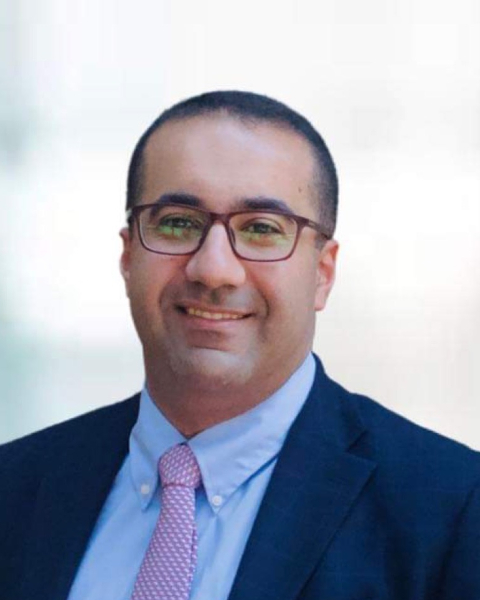PQA 05 - PQA 05: Breast Cancer and Nonmalignant Disease Poster Q&A
2712 - Comparing Protons vs. Photons on Breast Reconstruction Outcomes and Dosimetry Analysis
Monday, September 30, 2024
3:00 PM - 4:00 PM ET
Location: Hall C
Screen: 20

George Naoum, MD, MS
Northwesrn Memorial Hospital
Boston, MA
Presenter(s)
G. E. Naoum1, A. Yalamanchili2, A. Ho3, K. Dobinda4, M. Kocherginsky5, E. Nesbit2, E. D. Donnelly2, and J. B. Strauss2; 1Northwestern University McGaw medical Center, Chicago, IL, 2Department of Radiation Oncology, Northwestern University Feinberg School of Medicine, Chicago, IL, 3Northwestern University Feinberg School of Medicine, Chicago, IL, 4Northwestern Memorial Hospital, Chicago, IL, 5Northwestern University, Chicago, IL
Purpose/Objective(s): Previous single institution reports showed that Protons postmastectomy radiation (PMRT) can increase implant complications compared to photons. These reports are challenged by lack of external validation, lack of dosimetric analysis, lack of pre-pectoral reconstructions. Also, majority of patients in those reports had single stage direct to implant (DTI) reconstruction -not the commonly used two stages expander/implant (TE/I)- and only 13% of published cohorts received protons. Materials/
Methods: We reviewed all patients treated with mastectomy at our institution from 2011-2022. Patients receiving either Protons or photons PMRT in the presence of expander or implant prothesis were included. PMRT was delivered using conventional fractionation 1.8-2 Gy/fraction to a total dose: 50-50.4 GY in both groups. Protons were delivered using pencil beam scanning with an RBE equivalent to 1.1. Complications were based on surgical operative notes, reviewed by 2 physicians and included; infection/skin necrosis (I/N) requiring operative debridement, capsular contracture (CC) necessitating capsulotomy and absolute reconstruction failure (ARF) implying complete loss of reconstruction with no salvage options. Overall reconstruction failure (ORF) was defined as revisions leading to replacement of the implant or salvage autologous reconstruction. Subgroup analysis for Protons patients aimed to explore if any dosimetric parameter correlated with development of complications. Multivariable logistic regression models adjusting for confounders and competing risks analysis, compared complication rates between Protons and photon groups.
Results: Of 509 patients reviewed, 202 fit inclusion criteria with overall median follow-up of 4.6 years. 49 patients (24%) received protons while 76% received photons; 87% had TE/I and 13% were DTI; and 34% had pre-pectoral prothesis. The complications rates in Protons vs photons were as following on multivariable analysis: I/N (18% vs 13%, OR:1.5, p=0.3), CC (29% vs 10%, OR:4.2, p<0.001), ARF (16% vs 12%, OR:1.5, p=0.4), and ORF (55% vs 36%, OR: 2, p=0.03). Sensitivity analysis adjusting for PMRT timing in relation to exchange of expander to implant yielded similar results; where Protons remained significantly associated with CC and ORF (OR:3, p=0.01 & OR:2.3, p=0.02), respectively. Dosimetric analysis showed that neither (Dmean) nor (D1cc) for CTV, Implant and skin, respectively were associated with any complications. The 5-year local failure rates were not significantly different between Protons and photons (0% vs 4%, log-rank p =0.14).
Conclusion: Protons PMRT was associated with increased implant capsular contracture and reconstruction failures compared to photons, with no local control benefit. Dosimetric parameters were not associated with complications. The ongoing RADCOMP trial is not designed to detect reconstruction complications. Hence, careful patient selection weighing Protons benefit vs complications is warranted.
Purpose/Objective(s): Previous single institution reports showed that Protons postmastectomy radiation (PMRT) can increase implant complications compared to photons. These reports are challenged by lack of external validation, lack of dosimetric analysis, lack of pre-pectoral reconstructions. Also, majority of patients in those reports had single stage direct to implant (DTI) reconstruction -not the commonly used two stages expander/implant (TE/I)- and only 13% of published cohorts received protons. Materials/
Methods: We reviewed all patients treated with mastectomy at our institution from 2011-2022. Patients receiving either Protons or photons PMRT in the presence of expander or implant prothesis were included. PMRT was delivered using conventional fractionation 1.8-2 Gy/fraction to a total dose: 50-50.4 GY in both groups. Protons were delivered using pencil beam scanning with an RBE equivalent to 1.1. Complications were based on surgical operative notes, reviewed by 2 physicians and included; infection/skin necrosis (I/N) requiring operative debridement, capsular contracture (CC) necessitating capsulotomy and absolute reconstruction failure (ARF) implying complete loss of reconstruction with no salvage options. Overall reconstruction failure (ORF) was defined as revisions leading to replacement of the implant or salvage autologous reconstruction. Subgroup analysis for Protons patients aimed to explore if any dosimetric parameter correlated with development of complications. Multivariable logistic regression models adjusting for confounders and competing risks analysis, compared complication rates between Protons and photon groups.
Results: Of 509 patients reviewed, 202 fit inclusion criteria with overall median follow-up of 4.6 years. 49 patients (24%) received protons while 76% received photons; 87% had TE/I and 13% were DTI; and 34% had pre-pectoral prothesis. The complications rates in Protons vs photons were as following on multivariable analysis: I/N (18% vs 13%, OR:1.5, p=0.3), CC (29% vs 10%, OR:4.2, p<0.001), ARF (16% vs 12%, OR:1.5, p=0.4), and ORF (55% vs 36%, OR: 2, p=0.03). Sensitivity analysis adjusting for PMRT timing in relation to exchange of expander to implant yielded similar results; where Protons remained significantly associated with CC and ORF (OR:3, p=0.01 & OR:2.3, p=0.02), respectively. Dosimetric analysis showed that neither (Dmean) nor (D1cc) for CTV, Implant and skin, respectively were associated with any complications. The 5-year local failure rates were not significantly different between Protons and photons (0% vs 4%, log-rank p =0.14).
Conclusion: Protons PMRT was associated with increased implant capsular contracture and reconstruction failures compared to photons, with no local control benefit. Dosimetric parameters were not associated with complications. The ongoing RADCOMP trial is not designed to detect reconstruction complications. Hence, careful patient selection weighing Protons benefit vs complications is warranted.
